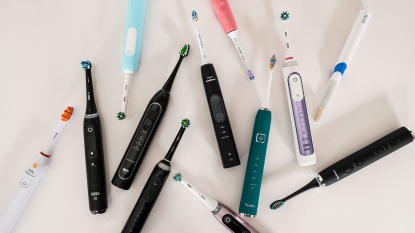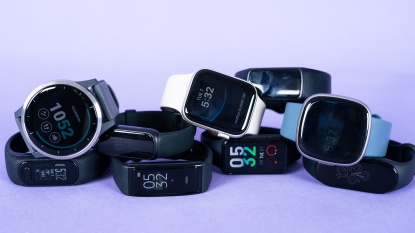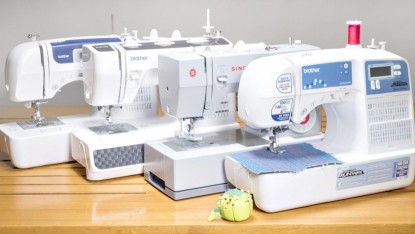Which electric toothbrush is best? Do you even need one? We took the highest-rated and most popular electric toothbrushes and put them through extensive side-by-side testing to find out which one is really the top electric toothbrush.
In our testing process, we learned what features and functions matter (and which ones don't), and if you actually need an electric toothbrush to keep your teeth happy and healthy.
Brushing your teeth in the morning and evening has been a part of your daily ritual for as long as you can remember. According to the American Dental Association (ADA), early forms of teeth cleaning methods ("chew sticks") have existed for nearly 5000 years, with bristled toothbrushes emerging in the last 500 years and the more modern, nylon-bristled type invented in 1938. Brushing is an essential part of good oral hygiene, removing plaque and preventing tartar accumulations and gingivitis. Plaque is a sticky film left on the surface of your teeth by bacteria, which can eventually harden into Tartar if not removed. Tartar is much more difficult to remove than plaque, and, if formed above the gum line, can cause swelling or bleeding. This swelling or bleeding is referred to as Gingivitis, a mild form of periodontal or gum disease that can lead to some more serious issues if left unchecked.
Why Get an Electric Toothbrush? Are They Really Better Than a Manual One?
Before looking at which is the best electric toothbrush, it makes sense to look at whether you actually need one. Some people may view anything other than a manual toothbrush as an unnecessary gimmick. In fact, if you use a manual toothbrush properly, twice a day for two minutes, and have healthy teeth according to your dentist, then there is NOT really a reason to buy an electric toothbrush. A manual toothbrush, when used properly, is plenty sufficient.
Electric or powered toothbrushes have been on the market for over 50 years, and studies have shown that brushing with an electric toothbrush can be more effective at removing plaque when compared to using a manual toothbrush. However, a manual toothbrush is more than sufficient for maintaining an acceptable level of oral hygiene when combined with good brushing habits. The ADA states that both manual and powered toothbrushes can effectively clean your teeth and recommends that you use a toothbrush that is comfortable, easy to use, and — most importantly — one that you will use for two minutes, twice a day. As such, various models of both manual and powered toothbrushes have received the ADA seal. However, the ADA also states that children may be more likely to use a powered toothbrush and that an individual who has difficulty using a manual toothbrush may get better results when using a powered toothbrush. This all ties back to an important point:
Pick the toothbrush model and type that you will actually use on a twice-daily basis.
There are studies that do show a statistically significant difference in favor of a powered toothbrush over a manual one. We are specifically referring to the 2014 Cochrane Group study which found that:
Because the clinical importance of these studies is still being analyzed, we would not recommend buying an electric toothbrush solely on the claimed effects that they are more effective at cleaning your teeth. If an increased cleaning performance is all that you are interested in and you are already brushing for the recommended amount, then consulting your dentist and getting their input is probably the best course of action. Your dentist knows your teeth infinitely better than we do and can recommend the best course of action.
Just to be clear, we aren't dentists or dental hygienists, and reliance should not be placed on this review for medical advice. Everyone's teeth are different, and you should always consult your dentist first when making decisions regarding your periodontal health.
So now it's time to get real and answer one of life's deep, soul-baring questions: Do you really, truly brush for two whole minutes, 120 seconds, twice a day, every day?
If the answer is "no," "I think so", or "maybe," then an electric toothbrush will improve your periodontal health. In our own experience, we found that an electric toothbrush was fantastic at improving our brushing habits. Having a two-minute timer on the toothbrush, especially with the notifications every 30 seconds, reinforces when you have not brushed for the specified time and helps ensure that you are evenly cleaning. For most of us, this is motivation enough to take home an electric toothbrush.
Types of Electric Toothbrushes
Oscillation/Rotation
These powered toothbrushes use a mix of oscillation or rotating motions to clean teeth and can be powered by either rechargeable or disposable batteries. These models operate at less than 20 Hz and do not produce an audible noise from vibration. To clarify, you can hear these toothbrushes but the movement of the brush head does not vibrate at frequencies audible to the human ear.
Sonic/Ultrasonic
These models strictly rely on vibrating brush heads in the 20 Hz to 20 kHz range, typically between 200-400 Hz, or 24,000-48,000 movements per minute. Ultrasonic toothbrushes operate at frequencies above 20 kHz, typically at 1.6 MHz, or 192,000,000 movements per minute. These vibrate at such a high frequency that the vibrations produced are inaudible to the human ear.
As of now, there are no definitive studies that demonstrate that more movements per minute correlate to better cleaning performance, healthier gums, or any noticeably different effect on your teeth. The toothbrushes in this review were all selected based on how widespread they were, their popularity, and existing information on them.
Which Type Is the Best?
The short answer? There isn't one.
There is still debate over the relationship between movements per minute and teeth cleaning, with no decision on best type of electric toothbrush. Manufacturers claim in their marketing campaigns that their type has been proven to be the best, but there is a distinct absence of definite information.
Big Mouth? We Have One, Too…
We looked at this problem a different way: Toothbrushes can't clean where they don't reach, and no toothbrush can clean if it isn't used. (sonic and ultrasonic toothbrushes do actually have an effect where they can disrupt plaque-causing bacteria a short distance from the actual bristles, due to interesting fluid dynamics. But you still have to maneuver the toothbrush to every section of your mouth. This means there is a great deal of significance on not missing spots when brushing, as well as comfort when brushing.
This leads to our title question: How large is your mouth?
Rotation-oscillation style models had the largest brush heads and were the least comfortable, proportionately less comfortable for those with smaller mouths. Look toward a side-to-side style brush if you have a mouth that is more petite.
For those with a history of sensitive gums, it is imperative to select a model that either has adjustable intensity or a sensitive mode.
For those with a large mouth and resilient gums, the world is your oyster when it comes to selecting an electric toothbrush. You are only constrained by budget, which leads to our next point.
Bourgeois or Bare-Bones?
There are low and high-end models of both styles — oscillating and side-to-side — with prices ranging from $30 to over $200, depending on features offered.
We would not buy any toothbrush that did NOT have the following features:- Made by an established company, ensuring replacement brush heads will be available.
- Two-minute timer, preferably with quadrant pacing.
- Some degree of customization, mainly a sensitive mode or a variety of brush heads.
- Battery life of at least a week.
Anything else that you pay for is pretty much fluff. Things like USB travel cases, aesthetic appeal, and fancy chargers are all nice, and they do add value to the product, but you are definitely paying for these additions rather than the actual teeth-cleaning attributes.
We also strongly recommend you consult with your dentist if you are looking at making this purchase to whiten your teeth. We found little-to-no evidence to back these claims.
Conclusion
Whether you choose a manual or electric toothbrush, the right toothbrush for you is one that makes it easier for you to maintain good brushing habits. For an in-depth comparison of the pros and cons of specific models, check out our electric toothbrush review.









